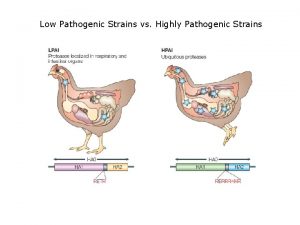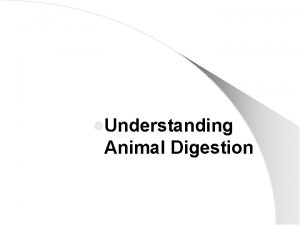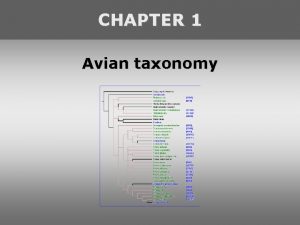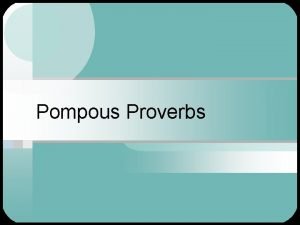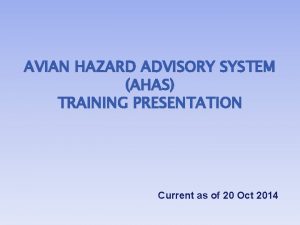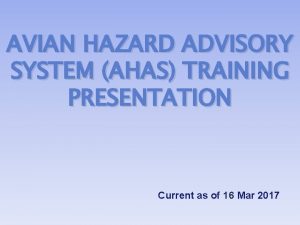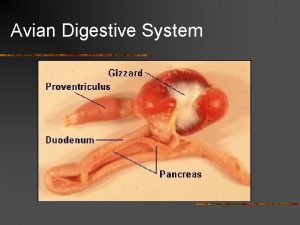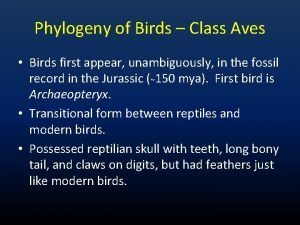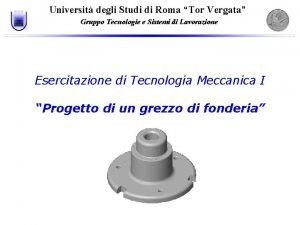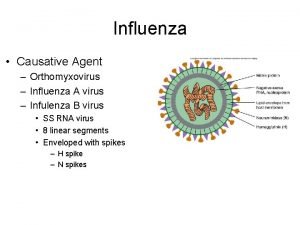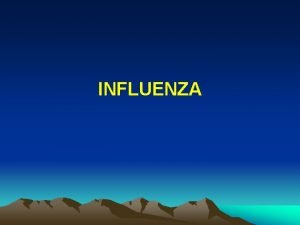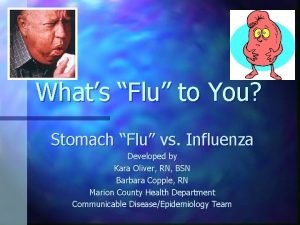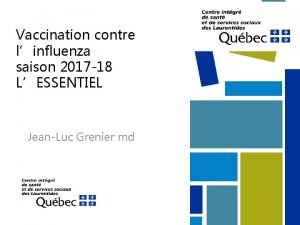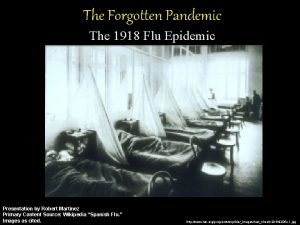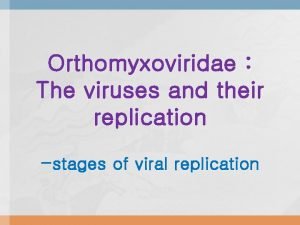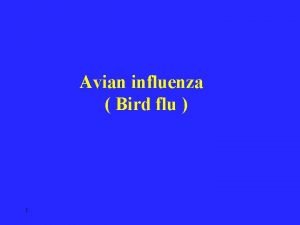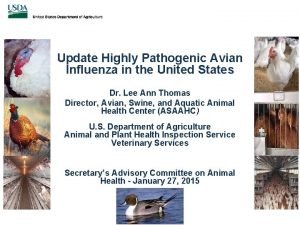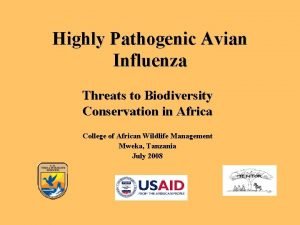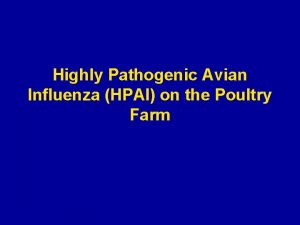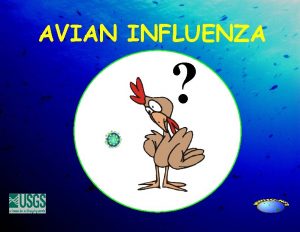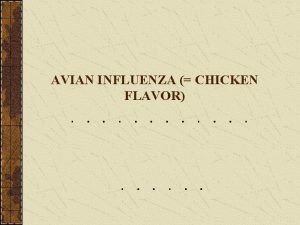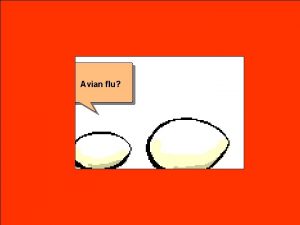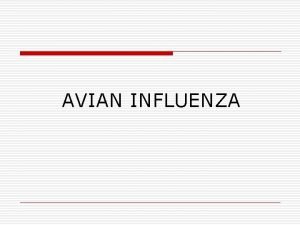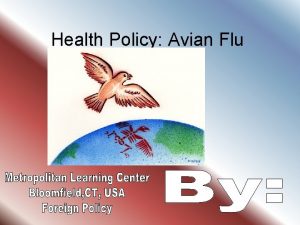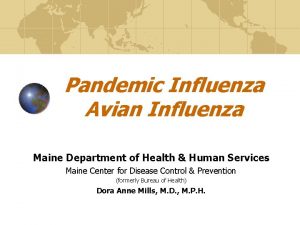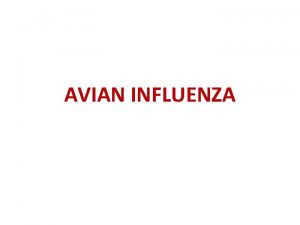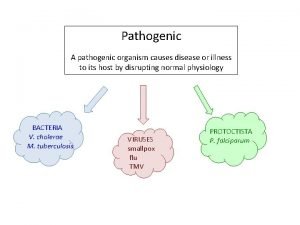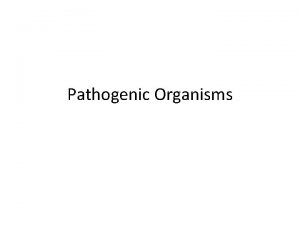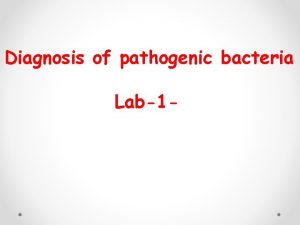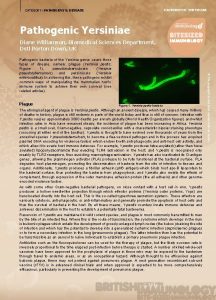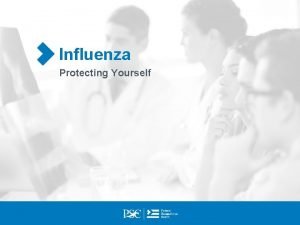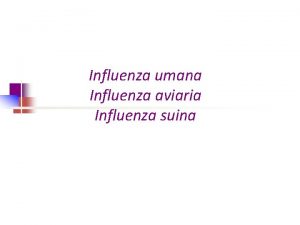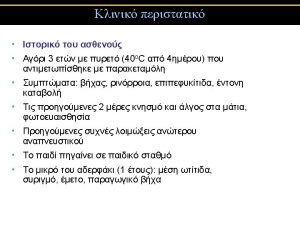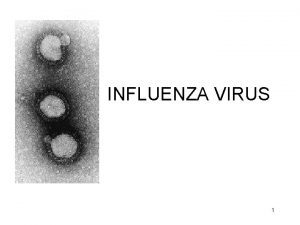Developing Parameters for Highly Pathogenic Avian Influenza Introduction






































- Slides: 38

Developing Parameters for Highly Pathogenic Avian Influenza Introduction to Epidemiologic Simulation Modeling August 6 -10, 2007 Fort Collins, Colorado, USA

Overview of NAADSM Input Parameters n Population n Production type, Number of animals, Geographic coordinates n Disease Manifestation n Susceptible to disease, latently infected, infectious & subclinical, infectious & clinical, and immune n Transmission n Direct contact, indirect contact, and aerosol transmission

Overview of NAADSM Input Parameters cont’d. n Detection and Surveillance n Passive and active disease surveillance n Control n Ring vaccination, movement restrictions, zones, and depopulation n Indirect Costs n Itemized costs associated with vaccination and depopulation

NAADSM Input Parameters 1. Population 2. Disease Manifestation 3. Transmission 4. Detection and Surveillance 5. Control 6. Direct Costs

Population Parameters n Sources Farm Service Agency (FSA) n Data from past outbreaks n Privately held data n Remote sensing n Farm Location and Animal Population Simulator (FLAPS) n National Agricultural Statistics Service (NASS) census data n

Population Parameters Farm Service Agency (FSA) n Characteristics of FSA n Must enroll in program n Only captures animal premises if land is used for multiple purposes (i. e. Corn and Chickens)

Population Parameters Data from past outbreaks n Characteristics of population data gathered from past outbreaks n Virginia’s LPAI outbreak n n n Geographically limited to the scope of the outbreak Temporally limited to the time of the outbreak Typographical errors and missing data

Population Parameters Privately held data n Characteristics of privately owned data n Accessibility n n Very few States have population data and even fewer are able to share it Data recorded differs by State n n Production type, number of houses (capacity), geographical coordinates Backyard flocks are usually missing

Population Parameters Remote Sensing n Arkansas Highway and Transportation Department n A map of all confined animal operations n Google Earth n Use satellite imagery and expert opinion to hypothesize the production type and flock size Source: Arkansas Highway and Transportation Department

Population Parameters Farm Location and Animal Population Simulator (FLAPS) n An automated process for developing hypothetical population data when true population data are not available n Poultry, Cattle, and Swine data n n n Geographic coordinates (latitude and longitude) for each farm Number of animals per farm Production type

Population Parameters National Agricultural Statistics Service (NASS) data n Characteristics of NASS data related to poultry n Layers n n Definition: Establishments primarily engaged in raising chickens for egg production. The eggs produced may be table eggs or hatching eggs. Pullets n Definition: Pullets used for laying flock replacement. § Pullets used to replace hatching egg layers/broiler breeders § Pullets used to replace table egg layers n Backyards n Must do $1, 000 of agribusiness to qualify as a farm

NAADSM Input Parameters 1. Population 2. Disease Manifestation 3. Transmission 4. Detection and Surveillance 5. Control 6. Direct Costs

Disease Manifestation n Latent period n Scientists from the Netherlands reconstructed the 2003 HPAI epidemic by quantifying flock-to-flock transmission and calculating the reproduction ratio. For purposes of this calculation, it was assumed that from the moment of introduction of the virus a flock would be latently infected for approximately two days. Source: Stegeman A, Bouma A, Elbers ARW, et al. Avian Influenza A Virus (H 7 N 7) Epidemic in the Netherlands in 2003: Course of the Epidemic and Effectiveness of Control Measures. J Infect Dis. 2004; 190: 2088 -2095.

Disease Manifestation n Infectious subclinical period n Scientists from The Netherlands estimated the infectious period for each flock to be the period between detection and culling, plus an extra four days to cover the time before the infection was detected but during which time birds were infectious. Source: Stegeman A, Bouma A, Elbers ARW, et al. Avian Influenza A Virus (H 7 N 7) Epidemic in the Netherlands in 2003: Course of the Epidemic and Effectiveness of Control Measures. J Infect Dis. 2004; 190: 2088 -2095.

Disease Manifestation n Infectious clinical period n One hundred percent mortality was observed in chickens reared on litter 48 to 96 hours after the onset of clinical signs. Source: Capua I, Mutinelli F, Marangon S, Alexander DJ. H 7 N 1 Avian Influenza in Italy (1999 to 2000) in Intensively Reared Chickens and Turkeys. Avian Pathology. 2000; 29: 537 -543.

Disease Manifestation n Infectious clinical period cont’d. n In caged layers, the disease moves slowly within the flock. The disease slowly spreads to neighboring cages reaching the end of the barn after 10 -14 days. Source: Capua I, Mutinelli F. A Colour Atlas and Text on Avian Influenza. Bologna, Italy: Papi Editore; 2001.

NAADSM Input Parameters 1. Population 2. Disease Manifestation 3. Transmission 4. Detection and Surveillance 5. Control 6. Direct Costs

Transmission n Transmission from farm to farm over large distances in British Columbia was likely due to contact movement of infected birds (early in. Direct the outbreak) or the result of mechanical spread by movement of Indirect contact people and contaminated equipment. Source: Lees, W. The 2004 Outbreak of Highly Pathogenic Avian Influenza (H 7 N 3) in British Columbia. Winter, 2004; accessed March 2, 2006. Web Page. Available at: http: //www. cahnet. org/bulletins. E/Cahnet. Bulletin 9 english. pdf.

Transmission n Direct contact n Subject matter experts n n Difficult to assign numerical values Variability due to differences in management practices between companies Contact rate Probability of infection transfer if source is positive Distance distribution of recipient units Effect of movement control on contact rates after detection

Transmission Direct Contact Source: www. webshots. com Will the producer introduce spiking males? How often will spiking males be introduced? If a male is infected, what is the probability that he will infect the flock he is introduced to? How far did the spiking males travel to their destination? What type of movement controls will be implemented if AI is detected?

Transmission Direct Contact Does the operation practice continuous flow? Are the turkeys moved from one farm to another? How often does this occur? If the source flock is infected, what is the probability that the receiving flock will become infected? How far did the flock travel? Will this type of movement pattern continue if AI is detected?

Transmission Indirect Contact Will the chicken catching crew go to another premises? How many premises will the catching crew go to today? What type of biosecurity is in place between premises and how effective is it? How far is the next broiler operation? What type of movement controls will be placed on the catching crew?

Transmission Indirect Contact Will these crews go to other premises? How many premises will they visit today? What type of biosecurity measures will be implemented? How far away is their next destination? What type of movement control measures will be implemented if AI is detected?

Transmission Direct and Indirect Contact n Backyard birds n Hobby n Shows & fairs n Small-enterprise commercial operations n Upland game birds n Birds raised for competition Source: North Carolina Cooperative Extension

Transmission n Commercial operations and backyard flocks n Is there a link?

Transmission Airborne Spread n Transmission could take place by airborne dissemination, but high volume air sampling collected during H 5 N 2 HPAI (1983/1984) outbreak in the U. S. failed to yield influenza virus when samples were collected more than 45 meters downwind from an infected premises. This suggests that airborne transmission may have a limited role in inter-flock dissemination of AI virus when compared with mechanical transmission.

NAADSM Input Parameters 1. Population 2. Disease Manifestation 3. Transmission 4. Detection and Surveillance 5. Control 6. Direct Costs

Detection n Probability of detecting signs based on the number of days the unit has. The been clinical probability that a contract grower/backyard n flock owner will observe clinical signs(H 7 N 3) outbreak in The first signs of illness during the 2004 HPAI increaseswere over atime. can reflected in British Columbia mild. This drop inbe egg production and feed youra parameters to account for an (six birds per day). consumption, and slight increase in mortality of observing The veterinarian increased and feed chance company representative investigated the problemwere as more birds in the flock become ill. lab for routine case and asamples submitted to the diagnostic post-mortem examination on February 9. The clinical signs appeared to resolve slightly over the next few days but on February 16, the lab reported that an avian influenza antigen had been detected. Within one day, mortality in a younger flock began to climb dramatically – from 25 birds one day, to 930 the next, and over 1, 500 on the third day. On March 8, the isolate was found to by highly pathogenic. Source: Lees, W. The 2004 Outbreak of Highly Pathogenic Avian Influenza (H 7 N 3) in British Columbia. Winter, 2004; accessed March 2, 2006. Web Page. Available at: http: //www. cahnet. org/bulletins. E/Cahnet. Bulletin 9 english. pdf.

Detection Awareness Differentials: Viscerotropic velogenic Newcastle disease Infectious laryngeotracheitis Acute poisoning Acute fowl cholera Septicemic diseases (E. coli) Bacterial cellulitis of the comb and wattles n Probability that a farmer or veterinarian will report signs of disease based on the number of days since the first detection in the population

Surveillance n Trace direct and indirect contacts n Contact days before detection n During the 2004 British Columbia HPAI outbreak, trace investigations were conducted for the movement of products, birds, equipment, and people 21 days preceding the onset of clinical signs or a positive test. Source: Lees, W. The 2004 Outbreak of Highly Pathogenic Avian Influenza (H 7 N 3) in British Columbia. Winter, 2004; accessed March 2, 2006. Web Page. Available at: http: //www. cahnet. org/bulletins. E/Cahnet. Bulletin 9 english. pdf. n Probability of trace success

NAADSM Input Parameters 1. Population 2. Disease Manifestation 3. Transmission 4. Detection and Surveillance 5. Control 6. Direct Costs

Control Depopulation n Consult your response plan or emergency management staff Will you depopulate detected diseased flocks? n Will detection trigger a destruction ring? n What will the radius of the ring be? n Will you pre-emptively destroy flocks? n Will you destroy direct contacts? n Will you destroy indirect contacts? n Will you destroy units within a ring? n

Control Depopulation cont’d. n Delay before implementing destruction programs n Consult your response plan n n The National Veterinary Stockpile will address stockpiling needs by acquiring, configuring, and maintaining critical veterinary supplies to ensure that these resources can be deployed within 24 hours of an adverse event. Analysis of past outbreaks n The goal during the British Columbia outbreak was to destroy birds within 24 to 48 hours of finding a positive flock. Source: Lees, W. The 2004 Outbreak of Highly Pathogenic Avian Influenza (H 7 N 3) in British Columbia. Winter, 2004; accessed March 2, 2006. Web Page. Available at: http: //www. cahnet. org/bulletins. E/Cahnet. Bulletin 9 english. pdf.

Control Depopulation cont’d. n Analysis of past outbreaks n Destruction capacity n The culling of infected flocks during The Netherlands HPAI epidemic started on March 4. In the beginning, culling was limited to 7, 000 birds per hour, but it increased during the following weeks and reached 750, 000 birds per day at the end of the epidemic in May. Source: Stegeman A, Bouma A, Elbers ARW, et al. Avian Influenza A Virus (H 7 N 7) Epidemic in the Netherlands in 2003: Course of the Epidemic and Effectiveness of Control Measures. J Infect Dis. 2004; 190: 2088 -2095.

Control Depopulation cont’d. What is the method of depopulation that will be used? Which production type are you depopulating? How many and what type of resources are available to use? If you got behind, how would you prioritize your efforts?

Control Vaccination Will you vaccinate? Which production types will receive vaccine? How many flocks will be detected before you implement your vaccination program? How many flocks can you vaccinate per day? If you get behind, how will you prioritize your efforts? How long does the vaccine protect the flock for? How long does it take before immunity is achieved? What is the minimum time between boosters? Will you vaccinate all of the flocks within a ring? What is this size of that ring?

NAADSM Input Parameters 1. Population 2. Disease Manifestation 3. Transmission 4. Detection and Surveillance 5. Control 6. Direct Costs

Questions?
 Low pathogenic avian influenza
Low pathogenic avian influenza Non pathogenic definition
Non pathogenic definition Avian digestive system
Avian digestive system Avian taxonomy
Avian taxonomy Avian ku ethnicity
Avian ku ethnicity Members of an avian species of identical plumage congregate
Members of an avian species of identical plumage congregate Avian hazard advisory system
Avian hazard advisory system Bam ahas
Bam ahas Avian digestive system
Avian digestive system Dispersal definition
Dispersal definition Aves taxonomy
Aves taxonomy Avian phylogeny
Avian phylogeny Modulo termico materozza
Modulo termico materozza Infulenza b
Infulenza b The great influenza rhetorical analysis
The great influenza rhetorical analysis Albert osterhaus
Albert osterhaus Influenza
Influenza Stomach flu vs influenza
Stomach flu vs influenza Is influenza a airborne disease
Is influenza a airborne disease Fibertel
Fibertel Influenza vaccine dosage chart 2019-2020
Influenza vaccine dosage chart 2019-2020 Influenza ww1
Influenza ww1 Influenza virus replication
Influenza virus replication Kontinuitetshantering i praktiken
Kontinuitetshantering i praktiken Typiska drag för en novell
Typiska drag för en novell Nationell inriktning för artificiell intelligens
Nationell inriktning för artificiell intelligens Ekologiskt fotavtryck
Ekologiskt fotavtryck Varför kallas perioden 1918-1939 för mellankrigstiden?
Varför kallas perioden 1918-1939 för mellankrigstiden? En lathund för arbete med kontinuitetshantering
En lathund för arbete med kontinuitetshantering Personalliggare bygg undantag
Personalliggare bygg undantag Vilotidsbok
Vilotidsbok Sura för anatom
Sura för anatom Densitet vatten
Densitet vatten Datorkunskap för nybörjare
Datorkunskap för nybörjare Boverket ka
Boverket ka Debatt artikel mall
Debatt artikel mall Magnetsjukhus
Magnetsjukhus Nyckelkompetenser för livslångt lärande
Nyckelkompetenser för livslångt lärande Påbyggnader för flakfordon
Påbyggnader för flakfordon
